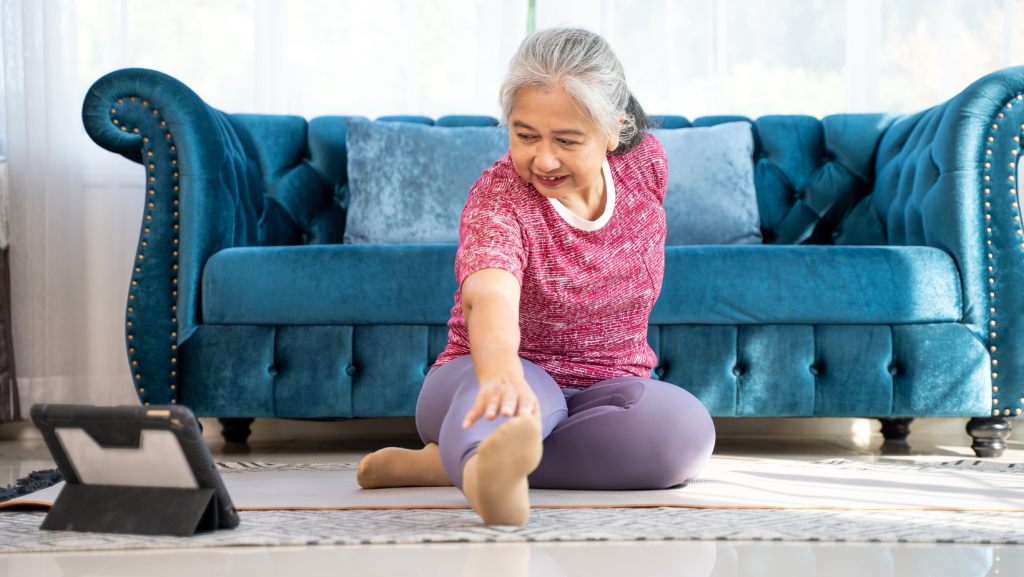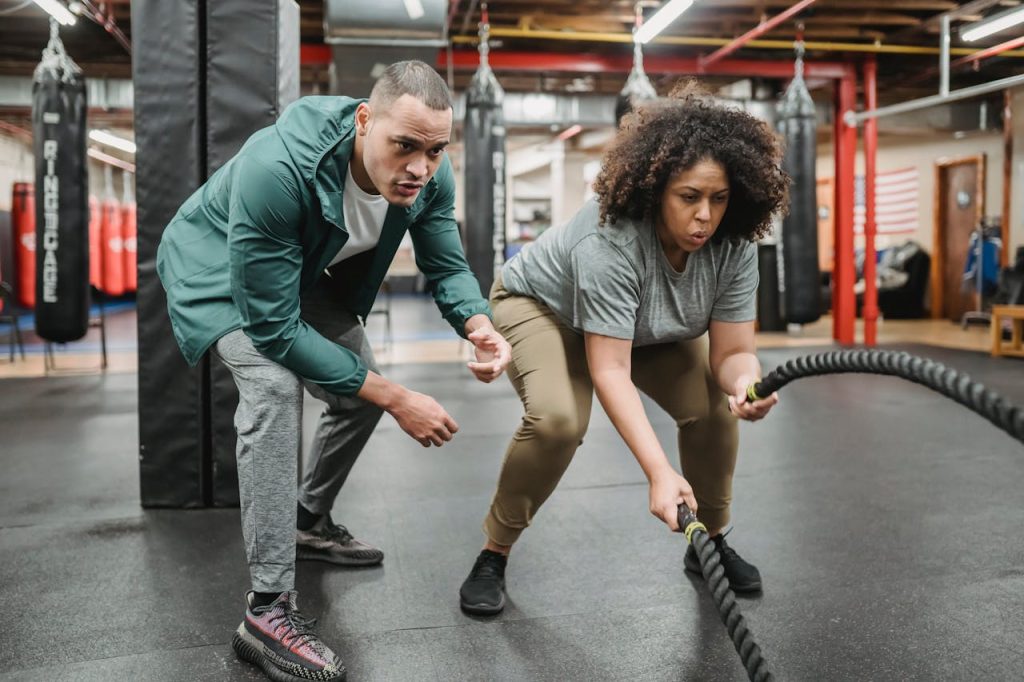Discover how corrective exercise can enhance mobility and balance for seniors. This article talks about how doing specific exercises can help older people move better and stay steady on their feet. It explains how doing certain exercises can make a big difference in how well seniors can move and do things physically. By focusing on specific movements and techniques, seniors can experience increased flexibility, strength, and stability, leading to a more active and independent lifestyle. Learn how these exercises can address common issues such as reduced range of motion and diminished balance, ultimately promoting a better quality of life. Explore practical tips and insights on implementing corrective exercises tailored to seniors’ needs. Elevate your understanding of the positive impact that targeted physical activities, using corrective exercises, can have on mobility and balance for older adults.

Common Challenges for Seniors
Movement Difficulties and Causes
Seniors often experience stiffness and have trouble moving their bodies as they age. This can make it hard for them to do things like walking, bending, or reaching for objects. The reason behind these difficulties is that as people get older, they tend to lose muscle mass and face issues with their joints. When seniors don’t move around much, their muscles become weaker and their joints become stiffer, making it even harder for them to stay mobile.
When muscles become weaker due to aging, it becomes challenging for seniors to perform simple tasks like getting up from a chair or walking up stairs. This lack of muscle strength increases the chances of seniors falling, which can result in serious injuries and impact their ability to live independently. That’s why seniors need to work on maintaining their muscle strength so they can continue to do everyday activities and keep moving comfortably.
Incorporating corrective exercises into a senior’s routine can help improve their flexibility, balance, and overall mobility. These exercises target specific muscle groups and joints, helping to increase range of motion and reduce stiffness. By engaging in regular exercise, seniors can strengthen their muscles, improve their posture, and enhance their coordination, ultimately leading to better balance and reduced risk of falls.
By focusing on corrective exercises that address their individual needs and limitations, seniors can experience significant improvements in their quality of life. These exercises not only help them move more easily but also boost their confidence and independence. It’s never too late for seniors to start incorporating corrective exercises into their daily routines to enhance their mobility and overall well-being.
Impact of Strength Loss
As we get older, our muscles tend to become weaker, which can make it harder for us to move around and do things on our own. This can be a big problem because it means we might be more likely to fall. Falling can lead to injuries that take a long time to heal, and it can also make us feel scared to move around in case we fall again. That’s why older adults need to keep their muscles strong. When our muscles are strong, it’s easier for us to do things like walking, climbing stairs, and even just getting up from a chair without needing help from someone else. By doing exercises that help strengthen our muscles, we can stay independent and keep doing the things we enjoy without having to rely on others for assistance.
Flexibility and Balance Issues
As we age, our bodies may not move as easily as they used to. This can make it harder for older adults to keep their balance and stay steady on their feet. When seniors have trouble with flexibility, it can affect their ability to move freely and comfortably. This lack of flexibility can also increase the chances of falling, which is a major concern for older individuals.
When seniors experience balance problems, they may start to feel scared of falling. This fear can be overwhelming and may cause them to limit their activities and movements. As a result, their mobility may decrease, making it harder for them to perform daily tasks and enjoy their favorite activities.
Corrective exercises are specifically designed to help improve flexibility and balance in seniors. These exercises focus on stretching tight muscles, strengthening weak muscles, and improving overall body awareness. By incorporating corrective exercises into their routine, seniors can enhance their mobility, reduce the risk of falls, and regain confidence in their ability to move safely and comfortably.
In addition to physical benefits, corrective exercises can also have a positive impact on seniors’ mental well-being. By feeling stronger and more stable in their movements, older adults can experience a boost in confidence and independence. This can lead to a greater sense of overall well-being and a higher quality of life.
Overall, focusing on improving flexibility and balance through corrective exercises is crucial for seniors looking to maintain their mobility and independence as they age. By incorporating these exercises into their daily routine, older adults can reduce the risk of falls, enhance their physical performance, and enjoy a higher quality of life.
Benefits of Corrective Exercises
Improve Mobility and Balance
Corrective exercises are special kinds of exercises that can help seniors move better and stay balanced. When seniors do these exercises, they can make their joints stronger and more stable, which helps them feel steadier on their feet. One example of a corrective exercise is called a single-leg stand. This exercise is when you stand on one leg for a short amount of time. By doing this, seniors can practice keeping their balance and building up their leg muscles.
Another helpful exercise is called heel-to-toe walks. In this exercise, seniors walk by placing the heel of one foot right in front of the toes of the other foot each time they take a step. This helps improve coordination and balance. When seniors regularly do these exercises, they can feel more confident when doing daily activities like walking or climbing stairs. So, it’s a good idea to encourage seniors to try these exercises to help them move better and stay balanced!
Enhance Posture and Wellness
Older individuals should engage in exercises that assist them in maintaining an upright posture and ensuring proper body positioning. This can help reduce any pain or discomfort in their backs and joints. When they have good posture, it also makes it easier for them to breathe well and have good blood flow around their bodies, which is awesome for staying healthy overall.
When seniors do exercises that focus on fixing their posture, they can experience a lot of cool benefits in the long run. For example, they might notice that they don’t feel as achy in their backs or joints anymore because their muscles are working better together. Plus, when they stand up straight, it can help them take deeper breaths and make sure that all their organs get the oxygen-rich blood they need to stay strong and healthy.
So, if older adults want to feel better and keep their bodies in tip-top shape, adding some posture correction exercises to their daily routine could be a really smart move!
Prevent Injuries and Aid Recovery
Seniors should prioritize engaging in corrective exercises to enhance their mobility and balance. These exercises can stop injuries and make it easier to move around. When we do these exercises, we can strengthen parts of our body that might be a little weak. This is helpful because it can make us less likely to get hurt when we’re moving around or doing everyday things. Plus, if we already have an injury, doing these exercises can help us get better faster. It’s like giving our body a little boost to heal itself. So, by learning about how our body moves and practicing these exercises, we can stay safe and healthy as we go about our day.
Customized Exercise Programs
Tailor to Individual Needs
Encourage customization of exercise programs for seniors based on their unique health conditions and goals. Personalizing routines is crucial for enhancing the effectiveness and adherence to the exercise program. By tailoring exercises, seniors can address specific mobility challenges they face, leading to better results.
Highlighting the significance of personalized routines helps seniors engage more actively in their fitness journey. When exercise programs are tailored to individual needs, seniors are more likely to enjoy the process and stick to their routines. This approach ensures that exercises are not only safe but also beneficial for improving mobility and balance.
Creating customized exercise programs involves understanding each senior’s limitations and strengths. By addressing these factors, professionals can develop effective corrective exercise plans that cater to the individual’s specific needs. Regular reassessments play a vital role in tracking progress and adjusting routines accordingly, ensuring continuous improvement.
Importance of Assessment
Thorough assessments are essential to identify mobility limitations and strengths in seniors. Professional evaluations provide valuable insights into designing effective corrective exercise plans that target specific areas needing improvement. These assessments help in creating tailored programs that focus on enhancing mobility and balance.
Professional evaluations play a key role in determining the right exercises for seniors to improve their overall well-being. By assessing mobility limitations, professionals can recommend suitable exercises that address these challenges effectively. Regular reassessments allow for modifications to the exercise program as seniors progress in their fitness journey.
Track Exercise Progress
Seniors need to keep track of the exercises they do to see how they are improving. By writing down the exercises they do and how they feel while doing them, seniors can better understand what works best for them. This log can show seniors how much progress they have made over time, which can be motivating.
When seniors see that they are getting better at something, it makes them feel good and want to keep going. It’s like a little reward for all the hard work they put in! Setting goals that can be measured, like being able to touch their toes or walk a certain distance without getting tired, gives seniors something to aim for.
When they reach these goals, it feels like a big accomplishment and encourages them to stick with their exercises. Plus, having goals helps seniors stay focused and dedicated to their exercise routine. So, keeping a log of exercises and setting measurable goals can help seniors stay on track and feel proud of their progress!
Consistency and Commitment
Build Routine Gradually
Starting with simple exercises is key to preventing injury and building a strong foundation for progress. Gradually increasing intensity and complexity ensures steady improvement over time. Consistency in exercise is crucial for seniors to maintain their mobility and balance effectively. Rest days are essential to allow the body to recover and adapt to the new routine.
Integrate into Daily Life
Seniors should look for opportunities to integrate corrective exercises seamlessly into their daily activities. Using household items as tools for resistance training adds variety to workouts. Incorporating balance exercises into daily tasks like standing on one leg while brushing teeth can improve stability. Making exercise enjoyable by turning it into a game or social activity can enhance motivation and adherence to the routine.
Use Technology for Support
Leveraging fitness apps provides seniors with guidance and structure for their corrective exercises. Online resources offer a wide range of exercise options tailored to individual needs. Wearable technology such as fitness trackers or smartwatches can monitor movement patterns and provide real-time feedback on performance. Virtual classes and telehealth sessions cater to seniors who prefer personalized instruction from the comfort of their homes.
Emotional and Psychological Benefits
Boost Confidence and Independence
Improved mobility and balance from corrective exercises can boost seniors’ self-confidence. Feeling capable and independent in daily life has lasting benefits for their emotional well-being. Seniors setting personal challenges foster a sense of achievement.
Improve Quality of Life
Enhanced mobility and balance lead to greater participation in social and recreational activities. Corrective exercises contribute to seniors’ overall physical and mental well-being. Improved mobility plays a crucial role in maintaining independence and quality of life.
Encourage Social Interaction
Group exercise classes are recommended to foster social connections among seniors. Exercising with friends or family provides motivation and support for seniors. Community resources offering group activities focus on mobility and balance improvement.
Closing Thoughts
The challenges faced by seniors can be alleviated through tailored corrective exercise programs, enhancing their mobility, balance, and overall well-being. By embracing consistency and commitment to these exercises, seniors can experience not only physical improvements but also emotional and psychological benefits. Customized programs catered to individual needs play a crucial role in promoting long-term health and independence among seniors.
Emphasizing the importance of personalized exercise routines and the positive impact they can have on seniors’ lives is key. Encouraging seniors to prioritize their physical health by engaging in corrective exercises regularly can lead to a more active and fulfilling lifestyle. Taking the initiative to explore these benefits further and implementing them into daily routines can significantly enhance the quality of life for seniors.

Frequently Asked Questions
How do corrective exercises benefit seniors?
Corrective exercises help seniors improve mobility and balance by targeting specific muscle imbalances, enhancing joint stability, and reducing the risk of falls. These exercises also aid in maintaining functional independence and overall quality of life.
Are customized exercise programs necessary for seniors?
Yes, customized exercise programs are crucial for seniors as they cater to individual needs, health conditions, and fitness levels. Tailored programs ensure safety, effectiveness, and motivation, leading to better outcomes in terms of mobility, balance, and overall well-being.
What emotional benefits can seniors gain from corrective exercises?
Seniors can experience improved mood, reduced stress levels, increased self-confidence, and a sense of accomplishment through regular participation in corrective exercises. Physical activity has been linked to enhanced cognitive function and overall emotional well-being in older adults.
Why is consistency important in corrective exercise routines for seniors?
Consistency is key in reaping the benefits of corrective exercises for seniors. Regular practice helps build strength, flexibility, and endurance over time. Consistent participation also establishes healthy habits and promotes long-term adherence to the exercise program.
How can corrective exercises address common challenges faced by seniors?
Corrective exercises target issues such as muscle weakness, joint stiffness, poor posture, and decreased balance commonly experienced by seniors. By addressing these challenges through specific exercises, seniors can improve their physical function, reduce pain, and enhance their overall quality of life.
Enhance Your Retirement Wellness with Personalized Coaching at Fitness Ellipsis!
Are you ready to embrace a more fulfilling and balanced lifestyle in retirement? At Fitness Ellipsis, we understand that true well-being in your golden years goes beyond just physical fitness—it’s about nurturing your mental, emotional, and physical health through holistic wellness practices. Our team of experienced coaches is dedicated to providing personalized wellness assessments designed to support your unique retirement goals.
Whether you’re new to the concept of wellness coaching or looking to elevate your current routine, we offer comprehensive, age-appropriate wellness programs to help you flourish in every aspect of your life. From individualized coaching plans to expert advice on mindfulness, nutrition, and physical well-being, we ensure that you stay energized, healthy, and purposeful throughout your retirement years.Don’t just wish for a more balanced retirement—make it happen! Join the Fitness Ellipsis community and embark on your journey toward a healthier, more vibrant, and fulfilling future. Connect with us today to discover how our personalized coaching services can transform your retirement. Your path to optimal well-being starts here!




